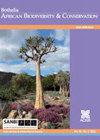Monitoring and conservation of the rare orchid Didimoplexis verrucosa in the face of change
IF 0.5
4区 生物学
Q4 PLANT SCIENCES
引用次数: 0
Abstract
Abstract Background: Didymoplexis verrucosa is a cryptic leafless saprophytic ground orchid (~70 mm tall) growing on the coastal forest floors of southern Zululand and classified as Vulnerable (D2). As part of a population monitoring programme, 960 man-hours of species specific searching over five consecutive flowering seasons were conducted, yielding only one individual plant. Objective: The aim of this study was to increase detection rate by developing a profile of environmental indicators for the accurate identification of suitable habitat. Methods: A detailed description of suitable habitat was compiled based on the Braun-Blanquet approach. Results: The results showed that key attributes shared by localities include similar topographic position in the landscape, hydrology, soils, vegetation composition and structure, forest age, leaf-litter composition of the forest floor, the co-occurrence of Isoglossa woodii, and a similar degree of protection from sunlight, wind and desiccation. Significance of the findings: This profile of essential habitat characteristics can be used as a surrogate in the absence of actual locality data when identifying target conservation areas and compiling management strategies for this very cryptic species. A by-product of this habitat analysis was the discovery of a long list of impacts on the long term survival of D. verrucosa. The combination of these stochastic and deterministic events will drive habitat change at rates beyond the species’ ability to adapt. Managing these variables forms the crux of its successful conservation. A conservation status revision, based on the formal IUCN criteria, indicate that D. verrucosa should be reclassified as Critically Endangered Category B2a and D.珍稀疣状双花兰花面临变化的监测与保护
摘要背景:疣兰(Didymoplexis verrucosa)是一种隐生的无叶腐生地兰,高约70 mm,生长在祖鲁兰南部沿海的森林地面上,被分类为易危(D2)。作为种群监测计划的一部分,我们在连续五个开花季节进行了960个工时的特定物种搜索,但只找到一株植物。目的:通过建立环境指标谱,准确识别适宜生境,提高检出率。方法:采用布朗-布兰凯法对适宜生境进行详细描述。结果:各地区具有相似的地形位置、水文、土壤、植被组成和结构、林龄、森林地表凋落叶组成、木刺草共生、遮阳、防风、防干等特征。研究结果的意义:在确定目标保护区和编制管理策略时,在缺乏实际地点数据的情况下,这种基本栖息地特征的概况可以作为替代。这种栖息地分析的副产品是发现了一长串对疣状棘球蚴长期生存的影响。这些随机事件和确定性事件的结合将以超出物种适应能力的速度推动栖息地的变化。管理这些变量是成功保护的关键。根据国际自然保护联盟(IUCN)的正式标准,对其保护状况进行了修订,表明疣沙应被重新归类为极度濒危物种B2a和D类。
本文章由计算机程序翻译,如有差异,请以英文原文为准。
求助全文
约1分钟内获得全文
求助全文
来源期刊

Bothalia
生物-植物科学
CiteScore
1.70
自引率
0.00%
发文量
12
期刊介绍:
Bothalia: African Biodiversity & Conservation is published by AOSIS for the South African National Biodiversity Institute (SANBI) and aims to disseminate knowledge, information and innovative approaches that promote and enhance the wise use and management of biodiversity in order to sustain the systems and species that support and benefit the people of Africa.
The journal was previously published as Bothalia, and had served the South African botanical community since 1921. However the expanded mandate of SANBI necessitated a broader scope for the journal, and in 2014, the subtitle, African Biodiversity & Conservation was added to reflect this change.
 求助内容:
求助内容: 应助结果提醒方式:
应助结果提醒方式:


